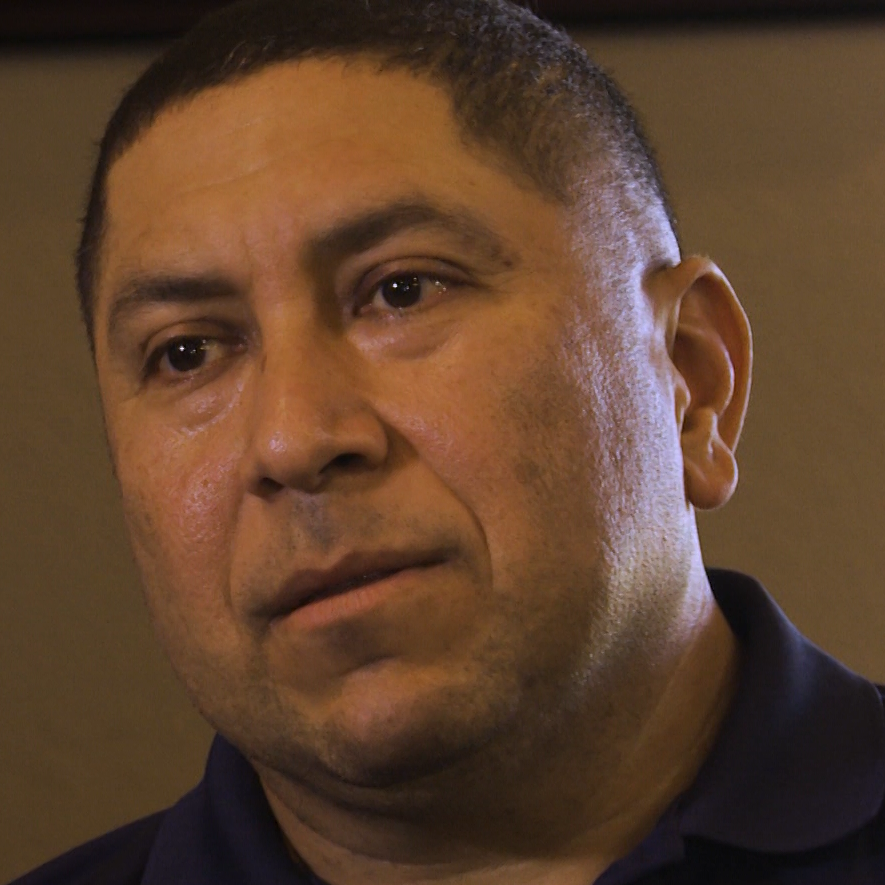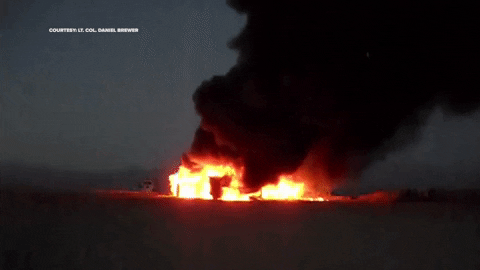WASHINGTON (NewsNation Now) — An estimated 3.5 million veterans may have been exposed to toxic fumes and carcinogens from burn pits, according to a U.S. Department of Veteran Affairs document.
The military used these open-air firepits to dispose of waste in the post-9/11 wars in Iraq and Afghanistan. Many vets now say they suffer from debilitating respiratory problems, even rare cancers and they say the government is not doing enough to help.

Retired Cpt. Le Roy Torres has been suffering from episodes since his 2007 deployment to Iraq.
“Clamp-like pressure on my head,” he said in a video that is tough to watch.
Every day he needs supplemental oxygen. All part of what he calls “the war that followed him home.”
“It’s a different type of war, but it’s scary, it’s invisible and it takes a toll,” he said.
Le Roy has been diagnosed with a toxic brain injury and a rare lung disease. He said he contracted at the base in Iraq, where he lived near a massive ‘burn pit.’
It’s an open-air pit, where the military burns its waste.
“It was plastics, Styrofoam cups, medical waste, body parts, military vehicle parts, tires. So pretty much everything that was thrown away was pretty much burned,” he said.
In a video taken in Iraq in 2005, the dark plume of smoke from the burn pit appears to blanket the base overnight.

Rich McHugh: On a day-to-day basis, this smoke from this burn pit would be filtering through camp?
Torres: By the morning you can actually, a stench was worse in the morning and you can actually see the soot outside your housing unit. I would just rub it over the little A/C and (it was) just like ash.
Torres experienced respiratory issues and said the clinic in camp gave him antibiotics, but they did not help, and the issues followed him back home, where he resumed work in Texas State Patrol.
“He began having a coughing spasm and couldn’t breathe,” Le Roy’s wife Rosie said. “And his airways were restricting and then ran to the bathroom and he collapsed. And our boys, like they’re in middle school and they’re like trying to pick them up.”
“I started missing work,” Le Roy said. “I report to work one morning and my sergeant says, ‘hey, uh, you’re, you’re sick. You can’t come back to work until you have answers there’s something wrong with you.’”
Rosie: Every time we went to VA or DOD health care facility and came back with, “we don’t know.”
McHugh: What did you think was wrong with you?
Le Roy: Honestly, I felt that there was something wrong with my lungs from exposure.
Rich: And the VA said what?
Le Roy: They said they couldn’t do the lung biopsy.

In 2004, at the request of the Department of Defense, Dr. Robert Miller, a pulmonologist at Vanderbilt University, examined over 250 soldiers who had come back from Iraq with unexplained respiratory issues.
He performed a lung biopsy on over a hundred of them.
McHugh: What did you find?
Dr. Miller: Surgical lung biopsies showed a number of things indicating toxic lung injury. The findings included scarring of the airways, either bronchiolitis or a condition called constrictive bronchiolitis.
McHugh: These findings suggested this is something that you get through inhalation?
Dr. Miller: All of these findings were compatible with toxic inhalation.
McHugh: Of the hundred soldiers that you have biopsied, how many had toxic lung injury?
Dr. Miller: All of them.
McHugh: Every single one?
Dr. Miller: Everyone.
Despite the fact that the VA did not recommend a lung biopsy for him, Le Roy paid out of pocket for Dr. Miller to perform one.
“I was diagnosed with the constrictive bronchiolitis and with fibrosis of my lungs. It was lung injury associated with toxic exposure,” Le Roy said.
McHugh: These soldiers have returned from Iraq and Afghanistan and they are facing all sorts of pulmonary problems, they believe, related to their deployment and burn pits. What do you say to them?
Dr. Miller: I don’t have any doubt that the patients that we have diagnosed with toxic lung injury have that as a result of their deployment. I also don’t have any doubt that the problem is much bigger than the number of people that we’ve evaluated at our institution.
I don’t have any doubt that the patients that we have diagnosed with toxic lung injury have that as a result of their deployment. I also don’t have any doubt that the problem is much bigger than the number of people that we’ve evaluated at our institution.
Dr. Robert Miller, Pulmonologist, Vanderbilt University
Le Roy and Rosie agree.
They started an advocacy group Burn Pits 360, and have enlisted doctors, veteran-owned companies like Grunt Style and celebrities like Jon Stewart to get people’s attention.
NewsNation requested the U.S. Department of Veterans Affairs provide their data in regards to how many vets have filed burn-pit related claims and how many have been approved. They have yet to respond to our request.
Data obtained by Burn Pits 360, through the Freedom of Information Act, said that of the 10,588 burn pit disability claims filed between 2007 and 2019, only 22%, or 2,360 were granted disability benefits.
Wes Black served as a gunner and a sniper.
“I was afraid to die in combat, but I came home and I was medically tired. I thought my time with everything in the military was behind me. I thought I had made it,” he said.
He received a Bronze Star with Valor and a Purple Heart for his service.
“There was a massive burn pit,” Black said. “It was a couple of football fields in size. I mean, it was absolutely massive and I remember during that deployment, breathing in this smoke and feeling choked up, you know, like it was very difficult to breathe at times.”
“Some of the things that were burned in those burn pits are carcinogens. They are absolutely carcinogens — plastics, metals. We can’t burn that stuff in our country,” he said.
Black took a photo of that burn pit in Iraq in 2005.

“In 2017, I was diagnosed with stage four, colon cancer,” Black said. “It has spread to my liver and my lungs and I was given anywhere between two and five years to live.”
Dan Perrone is Black’s attorney.
“When Wes initially filed a claim for disability benefits with the VA, due to his colon cancer diagnosis, he was denied,” Perrone said.
“They treat it like it’s, it’s not related to something that is so clearly evident,” Black said.
“The VA found that he hadn’t established the causal connection between his colon cancer diagnosis and his exposure to burn pits,” Perrone said.
“The scientific evidence doesn’t exist,” Black said. “It’s on their website, says that the VA says, ‘there’s no scientific evidence, correlating burn pits with any sort of medical issue.’”
But an internal VA document issued in 2010 references the toxins found in burn pits and the adverse effects each have on our body, including the GI tract. Which, for Black, connects it to his colon.
Black went to the Dana Farber Cancer Institute for a second opinion. There, the oncologist who examined him concluded that Black’s cancer could have been detected sooner if further investigation had been done earlier and that “it is likely his cancer was caused from Mr. Black being exposed to burn pits in Iraq.”
“And once he garnered that type of evidence, he was able to have his disability claim ultimately approved,” Perrone said.
Black is suing the VA for medical malpractice and he alleges that the government has fraudulently concealed the risks of burn pit exposure from veterans.
“I don’t want another vet to have to go through what I’ve gone through,” Black said.
“We’re trying to flip the script and put the burden back on the government to defend the position that they’ve been publicly taking for years,” Perrone said. “Forcing them to come back to us with evidence that shows that these burn pits actually don’t cause long-term adverse health effects as they’ve been claiming on their website for over a decade.”
Typically, a veteran suffering from a deployment-related illness files a service-related disability claim and that claim is either approved or denied based on evidence that the disability happened during service and, as Congress has mandated, the veteran should receive “the benefit of the doubt.”
Now some are saying that the VA is making it too hard for veterans to show they are entitled to benefits for claims relating to burn pit exposure.
Kerry Baker served as a Marine for 11 years, then as chief of the legislative and policy staff for the VA.
“They’re looking for proof, absolute medical proof that a certain exposure caused a certain disability, you’re not going to get it. It’s not how the epidemiology world works,” Baker said. “That’s not how the claims process works.”
He now works in the private sector on veteran claims related to toxic exposure.
In 2010, he helped write the policy for the Veterans Affairs on how to handle complicated issues like toxic exposures and burn pits claims, but Baker says the VA is not following that policy.
“The fundamental issue, in my opinion, is you’ve right now, but as of today you’ve got, a decent set of instructions on how to adjudicate these claims, that if VA was to follow that and just that, a lot more of these vets would get better decisions and fair decisions and correct decisions. I would not have to go through this appellate process,” Baker said.
McHugh: It seems like the U.S. government and Veterans Affairs is saying, ‘OK, you’ve served your country. You were in Iraq and Afghanistan. Now, years later, you’re back in the U.S. and you’re saying, you’re sick, but you got to prove to us that it’s related to that burn pit.’ Is that what’s happening?
Baker: In a lot of ways. Yes. You know, the VA is shifting the burden that they have to develop that case properly onto the veteran. They have to develop it properly; it’s not supposed to work like that.
NewsNation asked the Department of Veterans Affairs for an interview. They declined.

Former VA secretary David Shulkin agreed to speak with us. He said the problem goes beyond the individual claims process and that the system needs an overhaul.
McHugh: What was your position on burn pits when you were the Secretary of VA?
Shulkin: The burn pit issue was really just coming to the attention recognition about what was going on. And the initial response back when I was in the VA from 2015 through 2017, was, let’s make sure that we understand this issue. Let’s make sure that we collect data to be able to make the right decisions.
McHugh: If you go to the VA website, they say at this time, “research does not show evidence of long-term health problems from exposure to burn pits. VA continues to study the health of deployed veterans.” Do you agree with that?
Shulkin: I do not agree with that. And I’ve called for the VA to remove that from their website. It is not only inaccurate, but frankly, it’s insensitive to those who have served to go when they seek help. And they read the statement like that. There is clear data and published peer review studies that show that there are adverse health consequences, most of them respiratory, but that have demonstrated the relationship between burn pit exposure and poor health. And what’s worse than not helping somebody and telling them that you’re not going to help them is holding, is holding out false hope.
McHugh: Many of the veterans who served in these post-9/11 wars, with prolonged exposure to burn pits, say this is their generation’s Agent Orange. Do you agree with that?
Shulkin: I do. I think that is the case for 3.5 million of our veterans who served in Iraq and Afghanistan. There has been documented burn pit exposure. Now, not all of them, fortunately, are suffering from adverse health consequences, but many of them are. And that’s very similar to what we saw in Vietnam, where it was not intentional, but it was clearly a situation that we exposed our military to. And we as a country, have a responsibility to deal with that.
“The commonality between this generation’s Agent Orange, compared to the Vietnam era,” Le Roy Torres said. “It’s like history repeats itself.”
McHugh: Is there an easy fix to this?
Shulkin: Yeah, I do think there, I do think there is a fix to it. First of all, I think we have to be much more aware of the adverse health consequences, both physical and mental. The answer is you give the veteran the benefit of the doubt rather than make them suffer or worse, never get the help that they deserve.
“The VA needs to treat our returning service members better by taking care of them. By doing early screenings,” Black said. “And I really want people to know about this, the injustice of it all. Because my family, my 4-year-old son has to grow up without his dad.”
“It’s the price of war,” Le Roy said. “It’s huge.”





